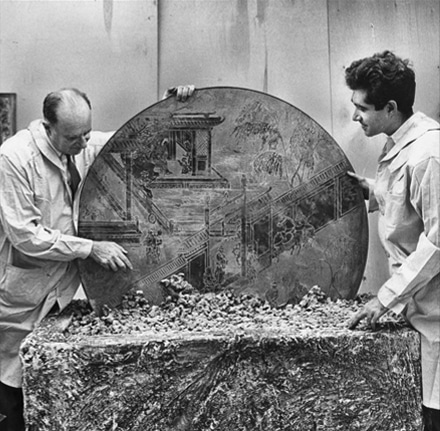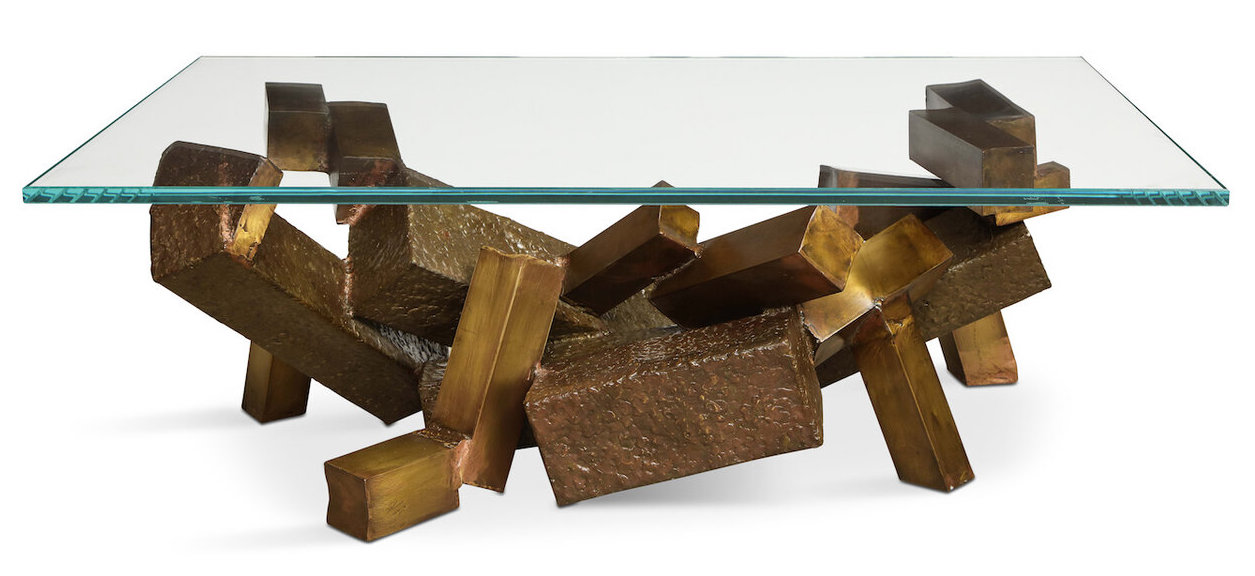Case Study: Philip & Kelvin LaVerne
Philip & Kelvin LaVerne: The Family Business
Philip (1907-1987) and Kelvin (b. 1937) LaVerne were a New York-based father and son collaborative duo best known for their use of innovative metalworking techniques to produce custom-made, limited editioned furniture which integrated art and design. Born in New York City, Philip LaVerne studied under Ashcan School painter John Sloan at the Arts Students League of New York. Kelvin LaVerne, also born in New York, pursued metal sculpting and furniture design at the Parsons School of Design and, like his father, studied at the Arts Students League as well. In the late fifties, the two began collaborating, eventually opening a showroom on East 57th Street in Manhattan. Working primarily in pewter and bronze, Philip’s role concentrated on the materials and decorative elements, while Kelvin focused on the overall form and functionality. Combining modern and traditional designs, their subjects centered mostly around historical civilizations, mythology, and chinoiserie, later gravitating towards more abstracted works. Patterns range from the figural, like “Chan”, “Ming” and “Festival” to the abstract, such as “Eternal Forest”, “Viola” and “Etruscan”. Since Philip’s death in 1987, Kelvin has ceased production of their famed Historical Series, however, he still creates pieces under both their names to this day.
Techniques
Philip and Kelvin LaVerne experimented with various techniques, including carving, acid etching, and enameling. A particularly ingenious method involved burying their pieces in a special soil and chemical mixture which over a period of six weeks would lend each item a unique, antiqued appearance. In the 1970s, the duo explored using molds to create cast pieces. Works by Philip and Kelvin produced this way are often one-of-a-kinds, as they quickly found the process both time consuming and expensive. After a few years, they moved on to hand-torching which led to the creation of abstract, bronze sculptures that served as bases for a variety of tables.
Philip & Kelvin LaVerne at Auction
Pieces by Philip and Kelvin have continued to maintain a strong presence in the secondary market which further demonstrates their steadfast demand.
– Their furniture examples predominately sell anywhere between four and five figures.
– The highest realized auction price was for a patinated bronze and pewter table with allegorical scenes for £100,000 GBP ($127,476 USD today) in 2018. This is one of only two known examples that have reached six figures.
– Pieces garnering the highest auction results generally have figural patterns than those with abstract designs. Furniture in the “Bathers” and “Chan” patterns have sold up to five figures.
– The cabinets are the most popular amongst collectors. The second example to reach six figures was a “Les Femmes” cabinet for $116,500 USD in 2011.
– Wall plaques are not as popular, but do have value in the secondary market; in 2019 plaques generally sold for three to the lower end of four figures.
– In 2019 and 2020, Case Antiques successfully sold two examples of the Eternal Forest coffee table for $16,640 USD each (incl. buyer’s premium), far above their pre-sale estimates.
Lot 509: Philip & Kelvin Laverne “Eternal Forest” Coffee Table
Lot 560: Philip & Kelvin LaVerne Eternal Forest Coffee Table
1. “Philip & Kelvin LaVerne Furniture Designer and Biography – Todd Merrill,” Todd Merrill Studio, July 24, 2019|, accessed July 21, 2020, https://toddmerrillstudio.com/designer/philip-kelvin-laverne/)
2. “Philip and Kelvin Laverne,” Artnet, accessed July 21, 2020, http://www.artnet.com/artists/philip-and-kelvin-laverne/)
3. Evan Lobel, “PHILIP AND KELVIN LAVERNE,” Lobel Modern NYC, June 03, 2016, accessed July 21, 2020, http://www.lobelmodern.com/bios/2016/6/3/philip-and-kelvin-laverne)
4. “Philip and Kelvin Laverne,” Artnet, accessed July 21, 2020, http://www.artnet.com/artists/philip-and-kelvin-laverne/)
5. Evan Lobel, “PHILIP AND KELVIN LAVERNE,” Lobel Modern NYC, June 03, 2016, accessed July 21, 2020, http://www.lobelmodern.com/bios/2016/6/3/philip-and-kelvin-laverne)
6. “Philip and Kelvin Laverne,” Artnet, accessed July 21, 2020, http://www.artnet.com/artists/philip-and-kelvin-laverne/)
7. “Philip & Kelvin LaVerne,” DONZELLA, accessed July 21, 2020, https://www.donzella.com/philip-kelvin-laverne)
8. Evan Lobel, “PHILIP AND KELVIN LAVERNE,” Lobel Modern NYC, June 03, 2016, accessed July 21, 2020, http://www.lobelmodern.com/bios/2016/6/3/philip-and-kelvin-laverne)


